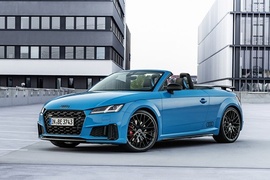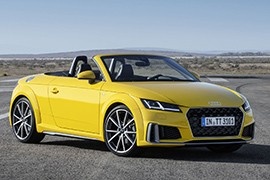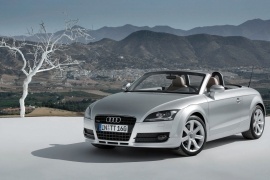
AUDI TT Roadster
Generations Timeline, Specs and Pictures

In late 2020, Audi unveiled a new version of its acclaimed compact roadster, the TTS.
Since its introduction in 1998, Audi TT was one of the most praised cars from the German carmaker lineup. Its shapes, initially designed by Peter Schreyer, looked like no other compact coupe on the market. The evolution followed, and in 2020 the car reached its third generation, which was launched in 2014. Despite a world pandemic situation, Audi pushed harder and introduced the Competition Plus for the TTS range.
The German carmaker installed standard LED headlights and a black Audi rings at the front. A black splitter was placed at the bottom of the apron. From its sides, the TTS Roadster Competition Plus showed the standard 20” light-alloy 10-spoke wheels and, behind them, a set of red-painted brake calipers. Its 39 kg (86 lbs) soft top could have been open and closed in 10 seconds at speeds up to 50 kph (31 mph). In the rear, a fixed-wing on the trunk amplified the car’s sportiness. Under the car, separated by a glossy black diffuser, the carmaker placed the four oval exhausts.
Inside, the driver stood in front of a 12.3 virtual cockpit that replaced the analog dials as a standard feature of the car. The Nappa leather with red or blue contrast stitching enhanced the interior’s look. The attention to detail was great, and the designers decided to add a stitched 12 o’clock marker red or gray on the flat-bottom steering wheel.
The TTS Roadster Competition Plus featured magnetic ride control for the suspension and a Quattro all-wheel-drive system. Power came from the 2.0-liter TFSI engine pushed to provide 320 hp via a 7-speed S-Tronic gearbox (dual-clutch).

Twenty years after the original Audi TT came on the market, and the compact roadster still looks fresh and strong.
In 2018, Audi introduced the stronger and faster than before TTS convertible. The exterior has been changed discreetly and brought a new three-dimensional Singleframe radiator grille design with the TTS logo on it, and larger side air inlets.
The TTS Roadster received further upgrades with a new full-length front splitter flanked by vertical inlets, exclusive side sills with inserts and, at the rear, vertical air inlets with horizontal fins below the rear lights and a different diffuser. The rear-view mirror cases are painted in silver for the TTS Roadster. The Audi TTS competition special model adds a sporty touch-with LED headlights, Audi rings laminated on the side sills, a fixed rear wing, brake calipers painted red, 20-inch wheels in high-gloss black and other exterior details in gloss black.
Inside, the driver has the Audi Virtual Cockpit, which featured an additional sport display, providing information on engine output, torque and g forces. The TTS version has its specific display menu, unavailable for the other TT models. Inside the air-vents from the central part of the dashboard, the designers installed displays for temperature, air-flow, and fan speed. A nice space-saving method.
The TTS features the quattro all-wheel-drive system from Audi and it has a lowered suspension by 10 mm (0.4”) compared to the rest of the TT range. It also features the Audi magnetic ride adaptive damper control,

In 2018, Audi introduced a facelift for its third generation of the TT range, including the coupe and the roadster versions.
The improvements went on more areas, and some minor changes were made for the exterior.
The exterior has been changed discretely and brought a new three-dimensional Singleframe radiator grille design and larger side air inlets. The new, optional, S line exterior package underscored the sporty character of the car. It included a full-length front splitter, a radiator grille in titanium black, and specific side sills with inserts as well as a sporty rear end. A wider diffuser was added to the back.
Inside, the driver had the Audi Virtual Cockpit, which featured an additional sport display, providing information on engine output, torque, and g forces. Inside the air-vents from the central part of the dashboard, the designers installed displays for temperature, air-flow, and fan speed. A nice space-saving method. The infotainment system, named MMI, was simplified and it featured just six key-buttons on the center console, between the front seats. It integrated a touch-pad on top of the rotary knob. Due to its retractable roof, the trunk space was smaller than the one in the coupe version. It only offered 280 liters (9.9 cu-ft) of space.
The 2018 model was fitted with the same 2.0-liter turbocharged engine and three power choices. It was mated with either a 6-speed manual or a 7-speed S-Tronic. A special version, TT RS, was offered with a 2.5-liter unit mated to a standard dual-clutch automatic gearbox.

The third generation of the Audi TT was introduced in 2014 at the Geneva Motor Show.
It was developed on the MQB platform used by many other cars in the Volkswagen group.
The original design of the TT was signed by Peter Schreyer in 1994, while he was working for Audi before moving to Kia as head of design. The idea behind the concept was a car with a low seating position, two seats, an engine in the front, and a front- or all-wheel-drive system. The concept remained, the technology evolved.
The TT Roadster featured a new, singleframe, grille with horizontal slats. The four-rings badge was moved on the hood to clear the grille area. The clear-cut headlights incorporated the LED daytime running lights. Despite some curved lines on the bodywork, the headlights were clear-cut in straight edges. There was an option for a full-LED or Matrix-LED lighting system. On the sides, the big wheel-arches broke through the hood gap, emphasizing the big wheels. Unlike its TT sibling, the TTS featured silver door-mirrors, regardless of the color of the car. A pair of twin-oval exhaust came under the rear bumper, with a wide diffuser between them.
Inside, there was a new Audi Virtual Cockpit for the instrument cluster. The big TFT display was used as a screen for the infotainment unit, named MMI. The newest generation was designed together with Nvidia and it used a Tegra 30 graphic processor. The dashboard featured five air-vents with a turbine design. The TT was fitted as standard a set of sport-bucket seats, named S-sport, was on the options list. Two silver safety arches were installed behind the seats.
The 2.0-liter TFSI engine (direct fuel injection, twin-turbocharged) offered 310 hp. It was mated as standard to a 6-speed manual and an option for 6-speed auto.

The third generation of the Audi TT was introduced in 2014 at the Geneva Motor Show.
It was developed on the MQB platform used by many other cars in the Volkswagen group.
The original design of the TT was signed by Peter Schreyer in 1994, while he was working for Audi before moving to Kia as head of design. The idea behind the concept was a car with a low seating position, two seats, an engine in the front, and a front- or all-wheel-drive system. The concept remained, the technology evolved.
The TT Roadster featured a new, singleframe, grille with horizontal slats. The four-rings badge was moved on the hood to clear the grille area. The clear-cut headlights incorporated the LED daytime running lights. Despite some curved lines on the bodywork, the headlights were clear-cut in straight edges. There was an option for a full-LED or Matrix-LED lighting system. On the sides, the big wheel-arches broke through the hood gap, emphasizing the big wheels. In the back, the clear-cut design for the taillights matched the headlights. These were fitted as standard with LEDs.
Inside, there was a new Audi Virtual Cockpit for the instrument cluster. The big TFT display was used as a screen for the infotainment unit, named MMI. The newest generation was designed together with Nvidia and it used a Tegra 30 graphic processor. The dashboard featured five air-vents with a turbine design. The TT was fitted as standard with sports seats with integrated head restraints. A set of sport-bucket seats, named S-sport, was on the options list. Two silver safety arches were installed behind the seats.
Under the hood, the TT was offered with a choice of gasoline and turbodiesel engines with a power ranged between 180 hp and 230 hp.

Audi TT has gone a long way since the first generation came out and, in 2008, there was the TTS Roadster that gathered the attention to it.
And there were a lot of reasons why.
There were not so many premium compact roadsters on the market in 2009. Some are sportier and some traded sportiness for comfort. In Europe, for instance, there were four models to choose from: the Audi TT roadster, the Jaguar F-Type, the BMW Z4 and, the Mercedes-Benz SLK. The Audi was the only one that offered an FWD platform with an all-wheel-drive system.
From the outside, the TTS roadster featured silver rearview mirrors casing, a specific mesh-grille with the TTS badge on it, gray side-sills and, in the back, a diffuser under the bumper to channel the air from underneath the car. The car featured standard 19” light-alloy wheels with an option for 20”. The four chromed tailpipes were also standard for the little Audi roadster.
Inside, there were two bucket-seats with high bolsters and fine leather on it. An upgrade fir Nappa leather was available at extra cost. It didn’t cost extra the Audi Cockpit, which meant that the instrument cluster was the display for the infotainment system. Since it was a TFT display it could be personalized. The infotainment system could be accessed via a large rotary knob on the center console.
Under the hood, there was the 2.0-liter TFSI engine mated to a standard 6-speed manual. A 6-speed S-Tronic dual-clutch gearbox was offered as an option.

The second generation of the Audi TT was unveiled in 2006.
One year later, the TT Roadster was shown to the public. It was an instant hit.
The first generation of the Audi TT suffered from an aerodynamic and suspension failure in development that was somehow fixed, but not entirely. On the second generation, that problem was completely resolved with a new platform and a new aerodynamic wing that was automatically extended at speeds over 120 kph (74 mph).
With the second generation, Audi started to work harder to gain more respect among the premium sports cars. Its main rivals, Mercedes-Benz and BMW, had the CLK and Z4, respectively. Audi took advantage of its all-wheel-drive system, which was not offered by the other two premium German car-manufacturers. The short front end, raked A-pillars and straight beltline carried the legacy of the first TT but better shaped. The double security arches behind the two-seat roadster were part of the attractive look. The power-roof could have been operated at speeds up to 40 kph (25 mph) and it only needed 12 seconds to completely open or close.
Inside, the TT Roadster featured two bucket-seats. Some parts of the interior were carried over from other Audi models. The instrument cluster featured a binocular-style dial for the speedometer and tachometer plus two other gauges for fuel level and coolant temperature. In the middle, between the two large dials, there was a small LCD display for the on-board computer.
Under the hood, the Audi TT Roadster was offered with a 3.2-liter V6 engine or with a 2.0-liter TFSI unit. Standard transmission was a 6-speed manual, but a 6-Speed automatic with paddle shifters behind the steering wheel was available as an option.

The 1999 Audi TT Roadster was the first roadster built by the Audi brand.
It was based on a new platform, with new engines and a new approach. And it was a success.
In 1995, the TT Concept-car was shown at the Frankfurt Motor Show. It was an unusual styling for the Volkswagen Group and the premium Audi brand. But it became reality in September 1998 when the coupe was launched, followed by the roadster in August 1999. And it had the name taken from the famous Tourist Trophy from the Isle of Man race.
The Audi TT roadster was built on the same platform with the Audi A3, the Volkswagen Golf, and the Skoda Octavia. But it featured a different styling. The rounded shape was unseen on any Audi before. It had a balanced design, with nearly the same proportions for the hood, cabin, and trunk.
Inside, the clean design was available with stitchings on the leather seats which looked like a baseball glove. No wonder, since the initial style was designed in Audi’s studios in California. It had room for two passengers.
Under the hood, there was a 1.8-liter engine with 5 valves per cylinder aided by a turbocharger. It was offered with two power outputs of 180 hp, and 225 hp, respectively. While the former was front-wheel-drive, the latter was available only as an all-wheel-drive. From the outside, the lesser version could be recognized by a single exhaust, while the top version had two pipes.























































